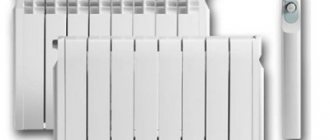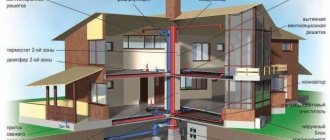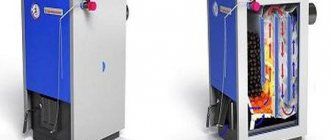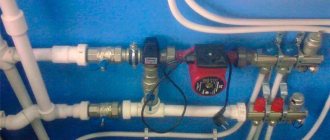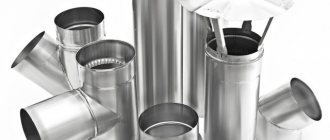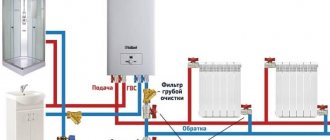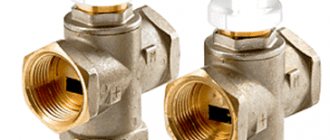Home / Electric boilers
Back
Published: 12/01/2019
Reading time: 4 min
0
2421
Arranging a heating system in a car garage, in situations where centralized heating services are not available, can be a difficult task.
Selecting the optimal electric heating scheme makes it possible to create the required sanitary and hygienic conditions in garage workshops at low outside temperatures, so owners of such premises need to know the basic rules on how to choose an electric boiler for a garage.
Example of EC location in a garage. Photo source: nizhniy-novgorod.dmir.ru
- 1 Types of boilers for garages
- 2 How to calculate boiler power
- 3 Requirements for installing an electric boiler in a garage
- 4 Best brands of garage electric boilers
- 5 How to connect
Two heating systems
There are two fundamentally different heating systems that can be used to heat a garage:
- air;
- water
Air heating is carried out using electric fan heaters, convectors, and oil radiators. This is the simplest heating method. To heat the air in the garage you will need a heating device and an electrical connection. However, after turning off the device, the temperature in the garage drops quickly. This type of heating is suitable if the car owner is in the garage occasionally and spends little time there.
Schematic diagram of water heating
The water system is more reliable. However, when installing it you will have to spend more money and labor. It includes three main parts:
- pipes through which the coolant circulates;
- heat emitter into space (battery);
- coolant heater.
Antifreeze is used as a coolant, since the heating in the garage is turned on periodically, and pipes filled with water can burst when frozen.
Heating boilers are used to heat the coolant. They can be of different types:
- gas;
- electrical;
- solid fuel;
- liquid fuel.
Choosing a heating type for a garage - advantages and disadvantages

If it is possible to organize water heating with a central gas supply, then other options are not needed - this is the most economical and convenient option, but, unfortunately, it is not available to everyone.
In terms of initial costs, installing water heating from a central gas boiler is an expensive undertaking. Requires underground laying and insulation of pipes, installation of radiators and installation of pipes indoors.
Advice. Metal-plastic pipes are much more profitable and practical than metal ones. Installation of metal-plastic does not take much time and is cheaper than welding.
Heating a garage using a heated floor system is an economical and convenient option with central water gas heating. Radiators and pipes take up a lot of space, get dirty quickly, produce high heat consumption and there is no way to place convenient shelves for tools.
Metal-plastic pipes with coolant are mounted directly into the concrete screed and uniformly heat the entire room. Therefore, the entire heating system is reliably protected from mechanical damage and warms up the car from below.
Wood or diesel boiler

Today, the cost of firewood, coal and even used diesel fuel has increased significantly. And in many regions it is no longer possible to claim that it is more economical to use wood heating than electric heating.
A simple potbelly stove will be able to maintain above-zero temperatures in a small, insulated garage, but it needs to be heated regularly; not everyone has the time for this. Coal and diesel fuel mean dirt and soot, and a ton of coal will cost exactly the same as you would spend on electric heating.
To heat 1 m3 of water to 50°C using electrics, the cost will be approximately 135 rubles; using diesel fuel, the same heating will cost 170 rubles. Therefore, now diesel and even waste fuel boilers are becoming unprofitable.
For all solid fuel boilers it is necessary to install a chimney, which also entails additional costs. According to fire safety rules for heating equipment, the height of the pipe must be twice the height of the building.
Long-burning solid fuel pyrolysis boilers
Relatively new types of heating that require loading fuel briquettes every two days. But the boiler itself is expensive and the fuel for it is also not cheap. If you calculate the payback, then in ten years this option will pay for itself.
Therefore, for a garage it is better to opt for electric heating - clean, convenient and, thanks to modern automation, inexpensive.
Gas autonomous heaters
It is not recommended to use gas cylinders in the garage as heating equipment, even if all safety measures are followed. If you decide to choose this heating option, then choose a heater with a closed combustion chamber and ceramic elements. Additional automatic switching on and off will save fuel consumption.
Pros and cons of electric boilers
Each type of boiler has its own disadvantages and advantages. The most optimal heat generator in modern conditions is an electric boiler.
Electricity is available everywhere, in cities and rural areas.
There is no need to install a chimney, buy and store liquid or solid fuel in the garage, or clean the boiler from soot.

Electric boilers are compact and easy to install
Electric boilers are very easy to use. Modern control systems allow them to operate automatically. They make it possible to turn on the heating without entering the garage.
Another advantage is ease of installation. Installing an electric boiler for heating a garage with your own hands is not difficult if you have minimal technical knowledge and work skills.
Electric boilers do not create an open flame to heat water or other coolant. This means they are safer from a fire safety point of view.
The efficiency of new models reaches 99 percent.
They are economical because automation allows you to smoothly regulate their power, thereby reducing energy consumption.
Finally, it should be noted that the industry offers a wide selection of electric boilers of various capacities, designs suitable, as they say, for all occasions.
There are far fewer disadvantages. It may be necessary to install additional wiring when installing a three-phase boiler. The electrical network to which the boiler is connected must have sufficient power for safe operation.
The price of the energy source remains controversial. Some critics point to the high cost of electricity. But prices for gas, electricity and other fuels are constantly changing, so it is difficult to give an unambiguous assessment.
The best heating boilers
If you decide to choose a high-quality boiler for your garage, you should study the manufacturers’ proposals and understand which models are more popular than others. Then you can be confident in the quality of the chosen model. How to choose which criteria to take into account?
Criteria for optimal selection of a heating system:
- price;
- productivity;
- safety;
- installation features.
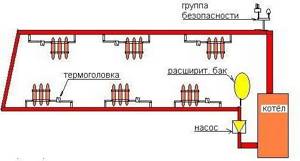
Based on these criteria, we will describe the main brands of electric boilers for the garage, which are in high demand in the domestic market and are worth the consumer’s attention:
- Baxi. An Italian brand known to customers all over the world, but it is most popular in European countries. Baxi models are distinguished by convenient adjustment, high efficiency, can operate in autonomous mode, and are capable of self-diagnosis. Baxi boilers are equipped with energy-efficient pumps that provide high efficiency. There are models that can be installed outdoors, but they are not cheap.
- Vaillant. The brand produces boilers with high performance and reliability thanks to the improved design of burners, the use of circulation pumps, and the creation of a casing made of high-quality steel alloys. Vaillant do not overheat and do not jam. But its large dimensions make it possible to place such a boiler only in a large garage.
- Protherm is a manufacturer that produces high-quality boilers of various capacities. Small-sized options are quiet, have an interesting design, and are often installed in motorhomes.
- It is also worth noting the products of the Ferroli and Bosch brands, which have also earned recognition from a large number of car owners.
A high-quality electric boiler for heating allows you to create optimal conditions inside the motorhome, turning it into a comfortable room for staying even in severe frosts outside.
Most car enthusiasts approach the arrangement of a garage for their “swallows” and “babies” with no less attention than the arrangement of their apartments. For example, they arrange heating. And they do the right thing, because in winter it significantly increases the comfort of being in the garage, allows you to carry out repairs normally, and makes it easier to start the engine.

Fan heater
Types of electric boilers
Depending on the heating method, boilers are divided into three types:
- heating elements;
- electrode;
- induction

Boilers of the first type have been known for a long time and are widespread. The heating element is heating elements (tubular electric heaters), made in the form of a spiral. An electric current flows through the heating elements and they heat up. The heat is transferred to the coolant, which is supplied to the system using a pump and circulates in it.
Disadvantage - heating elements can overheat and burn out if there is a lack of coolant. New heating elements electric boilers are necessarily equipped with protective devices that cut off the power supply if the coolant level in the system is insufficient.
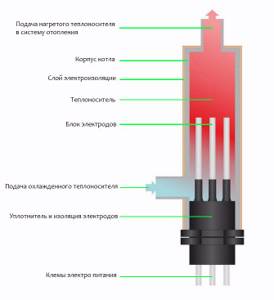
Electrode boiler device
An electrode boiler works on a different principle. Electricity in such a boiler is supplied to electrodes made of special alloys. The coolant acts as an element of the electrical circuit. It has a certain resistance, so the current passing through the coolant heats it.
Such boilers must have good grounding. If it is missing or poorly made, the risk of electric shock increases.
The main elements of an induction boiler are an electromagnetic coil and a heat exchanger. It consists of a metal core inserted inside the coil. When electricity is supplied to the coil, an alternating electromagnetic field appears in it. It creates eddy currents in the core that heat it. Next, the heat is transferred to the coolant.

Induction boiler SAV
Boilers differ according to the design of the body:
- wall;
- floor
Wall-mounted boilers are smaller and more compact. Floor-standing modifications are designed for boilers through which a larger amount of coolant passes.
Based on the electrical voltage, boilers are divided into:
- single-phase;
- three-phase.
In the first case, the operating voltage is 220 volts, in the second case - 380 volts. Boilers with a power of up to eight kilowatts are made single-phase. In the range of 8-12 kW you can find devices of both modifications. If the power is more than 12 kW, the boilers are available in three-phase versions.
Boilers are manufactured with different types of power regulation. Power adjustment allows you to change the heating temperature of the coolant and energy consumption.
Power can be adjusted:
- smoothly;
- by steps.
With stepwise adjustment, heating elements independent of each other are turned on and off.
Smooth regulation is done using a rheostat.
Low-power boilers of simple designs do not provide for adjustment of this operating parameter.
Electric boilers come in different configurations. An electric boiler without additional elements (pump for circulating coolant, safety valve, expansion tank, cleaning filter) is cheaper. But it is better to purchase boilers with a complete set. The listed items will have to be purchased separately, and in the end the cost of money may be large.
Where to start - thermal insulation and insulation
Drawing an analogy with a house, in a garage it is important not just to heat the room, but to keep the heat inside. And the first thing you need to start with is high-quality thermal insulation, otherwise you will simply heat the street. When the garage is a separate building, it is easy to insulate it. The walls are sheathed with heat-insulating material (foam plastic, expanded polystyrene, mineral wool, etc.), and, if necessary, covered with external finishing. If it is not possible to insulate the outside, work is carried out inside with the same range of materials.
The main task is not just to heat, but to keep the heat inside
The most important thing in such premises is the gate. This is a huge bridge of cold through which heat leaves the room almost instantly. We will not dwell in detail on the description of the work; this information is more than clearly presented in the article “Insulating a garage door with your own hands.”
A separate door in the gate will help reduce heat loss, but this is more an ideal than a real option.
Heating system design
Heating system - generator, radiator and pipeline
So, we have an insulated garage. What's next? And then we decide on the heating system, which includes 3 required elements:
- heat generator;
- emitter;
- transmission system.
Heat generator - in our case, this is heating the garage with an electric boiler. In others, there may be a stove, including mining, a fireplace and other autonomous heating sources.
The simplest and most inexpensive way to heat a garage is the “Potbelly stove” or its more advanced version “Buleryan”. They warm up quickly, give off heat effectively, but do not distribute heat well throughout the room.
Heat emitter - elements through which heated air is transferred into the room. These can be heating batteries or an air thermal electric heater (TEH).
The transmission system is a pipeline through which the coolant circulates.
If the garage is electrified and radiators are installed to circulate the coolant, the optimal solution would be to install an inexpensive electric boiler. It is very simple to calculate its boiler power - 1 kW/10 sq.m. + 15-20% on stock.
For example, in a garage with an area of 20 square meters, the optimal electric boiler for heating is 3 kW. This is subject to high-quality insulation. If the metal gate is not insulated, more than 5 kW will be required; if the gate is closed with at least foam plastic, but there are cracks in the walls, 4-5 kW will be enough.
VIDEO: How to heat a garage with 1 kW power
Types of electric heating boilers
Electric heating boilers can be of different types. The operating principle of each is to heat the coolant and ensure its movement through pipes installed in the room.
If an electric boiler for a garage operates constantly in winter, water is suitable as a coolant. If the light or boiler is periodically turned off, it is recommended to use antifreeze. It will not freeze and, accordingly, will not burst the pipes.
All electric boilers are divided into 3 main types according to the method of heating the coolant:
There are also single-circuit (for heating only) and double-circuit (heating + hot water supply), wall-mounted and floor-mounted devices, options powered from a single- or three-phase network.
heating elements new
Such devices are equipped with a tubular electric heater (abbr. TEN) - an electrical device made in the form of a tube and designed for heating. Their number depends on the required power for your garage. The price category is average - 10-15 thousand rubles. Example: Vulcan turbo Galan 18 kW 12,500 rub.
Electric boiler equipped with heating element
The disadvantage of such devices is the gradual formation of scale on the heating element, which leads to a decrease in efficiency and an increase in energy consumption.
Induction
These are the most convenient electric boilers to use for heating a garage, as they operate on an alternating electromagnetic field. It is under the influence of this field that the metal, which is the heating element, heats up and transfers this heat to the coolant. Such devices have not yet passed the “test of time,” but their performance and theoretically possible service life are impressive. That is why the price for them is appropriate - from about 30,000 rubles, for example, a vortex induction heater 5 kW VIN costs 33,250 rubles.
Considering the high cost, it is more rational to use them in the same heating system with the house, or when the garage is also a place of work, such as a workshop.
Electrode
Electrode electric boilers for heating will be a very economical option. They generate alternating current with electrodes. In general, their operation is very economical, saving up to 30-40% of electricity. But for them to work, they need a special liquid with a specific composition, and it can be expensive. Even in this case, this option is quite economical - for example, the “Ochag 5 kW” heater costs 4,000 rubles.
Electrode electric boiler
Thus, calculating costs and choosing a model depends not only on financial capabilities, but also on needs. That is, to determine what exactly is needed, several factors are taken into account:
- planned frequency of use;
- the need for automation;
- need for hot water;
- Is there a production or workshop on the premises?
Based on these factors, you can easily determine which electric boiler for your garage is best suited. Electrode electric boilers for garage heating are more convenient in terms of automation; they are quite capable of autonomous operation.
To force the coolant to move, it is also necessary to use a circulation pump.
Requirements for installing an electric boiler
When connecting an electric boiler in a garage with your own hands, you must comply with the standards set out by the PUE dated 07/08/2002. No. 204 and technical features of the selected model.
If equipment with a power of up to 8 kW is installed, this qualifies as the installation of a household water heating device, where permitting documentation is not required. Connection of heating elements or induction models is carried out through an RCD and automation; no such exceptions are provided for electrode models.
The heating element unit is already equipped with all the necessary arsenal for operation, including a pump and automation
For electric boilers with a power of 8 kW or more, a connection to a three-phase power supply (380V) is required. This can only be done by an electrician with a clearance group of at least IV.
The first step is to mount the unit itself on the wall or floor, depending on the chosen model.
The minimum distance from the floor to the heating element boiler is 150 cm. Induction and electrode ones are installed in a way that is convenient for piping, but only vertically.
The easiest to connect will be the heating element model - they are already equipped with a circulation pump and automation. It is enough to simply install, connect and make a harness, as in the picture
Choosing an electric boiler
The choice begins with determining the required power. This is not difficult to calculate. There is a classic ratio: to heat 10 square meters of an insulated room, the ceiling height of which is not higher than three meters, you need one kilowatt. Thus, you need to calculate the garage floor area. If it is, for example, 30 sq. m., then you need a device with a power of at least 3 kW. Next, you need to make an adjustment of 15-20%, as they say, in reserve. As a result, the optimal power is 4 kW.
Therefore, the boiler will be single-phase. There is no need for additional wiring.
However, the above does not mean that it is impossible to install a boiler of higher power. In this case, heating will occur faster, but the cost of a more powerful device will be higher and electricity consumption will increase.
The next parameter influencing the choice is price. It depends on the degree of advancement of the device. The more electronic filling with increasing functions, the higher the price. Whether extensive functionality is needed is up to the garage owner to decide. It should be noted that the more complex the device, the more likely it is to fail.
The most expensive are induction, followed by heating elements in next place in price. The cheapest are electrode boilers.
The next parameter is the manufacturer. The brand of a well-known manufacturer is a guarantee that the boiler will operate reliably and provide heating in accordance with the characteristics specified in the technical data sheet.
Principle of operation
The fundamental difference between such a stove and other types is that the cookware is heated not by an open flame (as in gas stoves) or a metal heating element (as in conventional electric stoves). Cookware on an induction hob is heated by the movement of electromagnetic currents passing through a magnetic coil under the glass-ceramic surface.
This operating principle allows us to draw the following conclusions.
- Only cookware that has ferromagnetic properties will heat up. But this does not mean that you will need to buy something special. The old one may be fine.
How to check if a particular pot or pan is suitable? Bring a magnet to its bottom or look at the symbols. See the picture below for what the “induction” icon looks like.
Use pans with a flat bottom and no dents or bulges.
- Only the part of the stove under which the pan is placed will heat up. The glass-ceramic surface of the stove is already heated by hot dishes, and if you remove a hot pan from it, it will quickly cool down in a few seconds. Thanks to this, there is less risk of getting burns (only if from hot dishes during cooking).
This feature of her work is very relevant for families with small children. Even if a child turns on the stove, it will not start to heat up unless there is a pan with a magnetic bottom on it.
Electricity is consumed more economically due to the narrowly targeted effect of heat, and food that gets on the surface does not burn.
The induction oven is easy to clean.
- The dishes must be of a suitable diameter - at least 12 cm. This means that an accidentally forgotten fork or spoon on the stove will not heat up. Well, you will have to give up the usual little Turk. Instead, you can buy a special one or purchase an adapter - a metal disk of the diameter required for heating the stove.
Attention! When using an adapter disk, it is not recommended to turn on the equipment at full power.
Watch an interesting video about the pros and cons:
Insulation of the garage
Before installing heating, it is necessary to properly insulate the garage, since heat leaks through the floor, roof, walls and doors significantly reduce heating efficiency and increase costs. Insulation is carried out using thermal insulation materials (mineral wool, polystyrene foam, polyurethane foam). Garage door leaves are sealed with special seals for this purpose.

Electrical connection diagram
Popular models
- One of the most popular models is EVAH C1 7.5 220. The heating elements are made of stainless steel. If they fail, they are very easy to replace. The temperature is regulated by a built-in thermostat. It is possible to use a remote thermostat. Two-stage protection against coolant overheating is provided. Very easy to install. The disadvantages include the lack of a pump.
- The heating elements and bodies of the ZOTA 12 Lux boilers are made of stainless steel. The body is finished with vinyl wallpaper. The boiler is light in weight and dimensions, which makes it easier to choose where to install it. Connection for heated floors is provided. An easy-to-use control panel makes it easy to configure the operation of the device. Cons: lack of a pump included and noise during operation.
- The RusNIT 270 boiler can be used to heat both a garage and any other residential and domestic premises. It is possible to connect a boiler, heated floors, a room thermostat, and a GSM module.
A module is a small device that processes and transmits information from the boiler to the user and vice versa in the form of text messages. It is needed for a quick response to changes in the operation of the autonomous heating system.
Sensors that monitor the temperature and filling level of the system make the operation of the electric boiler completely safe. There is a three-stage power adjustment (30%, 60% and 100%).
- The Protherm Skat 6K boiler has a very high efficiency (99.5%). The temperature in the heating circuit is adjustable in the range from 30 to 85 degrees. The heat exchanger is made of stainless steel. Equipped with all necessary automation. A very convenient display that shows all operating parameters. The disadvantage of boilers from this company is their somewhat inflated price.
You can purchase good boilers from other manufacturers (Kospel, Dakon, etc.).
Craftsmen can make a boiler themselves, but this is only for people who have the necessary skills.
Electric boilers have a whole range of advantages when installed in a garage compared to fuel-fired boilers. They are compact, easy to install, easy to operate and maintain. The only limitation for use can be the insufficient power of the electrical network, but since most garages do not require powerful electric boilers for heating, this obstacle is quite conditional.
Additional information on the topic of the article can be found in the video.
You can learn how to make an electric boiler yourself from the video.
Average score of ratings is more than 0
Share link
Comments There are no comments yet, but you could be the first...
Types of electric boilers installed in garages
To choose the right electric boiler for your garage, you need to understand the operating principle used and the associated limitations during operation. There are three types of boilers, differing in their internal structure and principle of heating the coolant:
- Heating element boilers are classified as indirect heating devices. The internal structure of the electric boiler consists of a thermally insulated container, inside of which a heating tubular element is located. The design disadvantage is large heat losses due to indirect heating, as well as the long period of time required for the boiler to reach operating power.
- Electrode boiler – has high energy efficiency. Compared to heating elements, efficiency reaches 40%. The heating principle is based on direct action on the coolant. The device uses two electrodes that create an electromagnetic field and cause the ions to move at a frequency of 50 vibrations per second. The coolant heats up almost instantly. The disadvantage of electrode boilers is the inability to use the unit when connected to low-temperature heating systems. The operation of an electric boiler requires the use of a special coolant with a high salt content.
- Induction boilers - the operating principle is based on the use of an alternating electromagnetic field. A copper core is installed inside the structure. When the electric boiler is turned on, vortex electromagnetic flows or Foucault currents are created. Under the influence of a magnetic field, the metal heats up and transfers heat to the passing coolant. Induction boilers, like heating elements, belong to indirect heating equipment, but are characterized by longer operation. Therefore, electric boilers based on a tubular heater are more economically profitable.
Heating elements, electrode and induction electric boilers for garage heating systems have their advantages and disadvantages. When choosing a suitable model, the characteristics of the heated building are taken into account and the boiler is selected in each specific case.
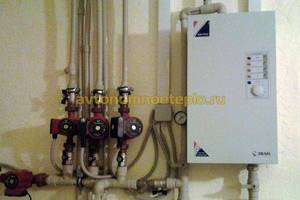
(no votes yet)
